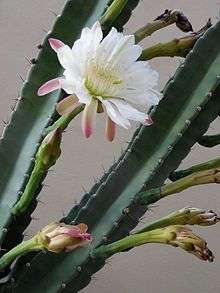Cereus hildmannianus
| Cereus hildmannianus | |
|---|---|
 | |
| Scientific classification | |
| Kingdom: | Plantae |
| Clade: | Angiosperms |
| Clade: | Eudicots |
| Order: | Caryophyllales |
| Family: | Cactaceae |
| Subfamily: | Cactoideae |
| Genus: | Cereus |
| Species: | C. hildmannianus |
| Binomial name | |
| Cereus hildmannianus K.Schum.[1] | |
Cereus hildmannianus is a species of cactus from southern South America. Its distribution is uncertain but probably includes Brazil, Paraguay, Uruguay and Argentina.[1]
Description
Cereus hildmannianus has a tree-like growth habit with a distinct trunk after which it branches freely up to 10 m (33 ft) high. Its stems are up to 15 cm (6 in) across, have 4–6 ribs and are divided into segments. They are blue-green in colour when young, becoming duller green with age. Stems are usually spineless (except in subspecies uruguayensis). The white flowers are very large, up to 25–30 cm (10–12 in) long, and are followed by fruits which are red when ripe.[1]
Systematics
Cereus hildmannianus was first named by Karl M. Schumann in 1890. Plants named as Cereus uruguayensis by Roberto Kiesling in 1982 were reduced to C. hildmannianus subsp. uruguayensis by Nigel P. Taylor in 1998,[1] thereby creating the autonym C. hildmannianus subsp. hildmannianus. Subspecies hildmannianus has the same range as the species as a whole and is usually spineless, unlike subsp. uruguayensis which is only found in Uruguay.